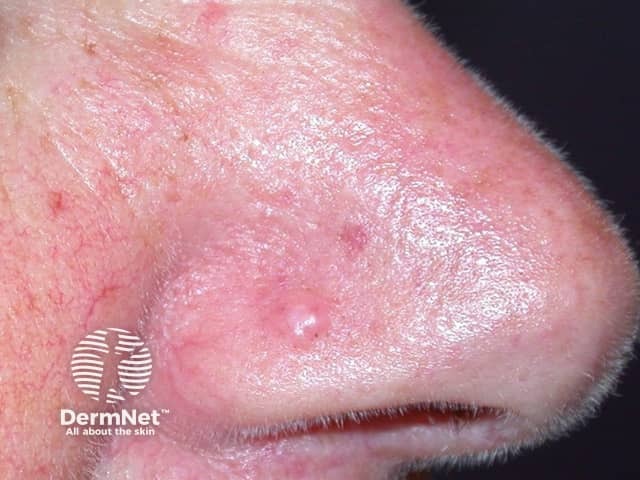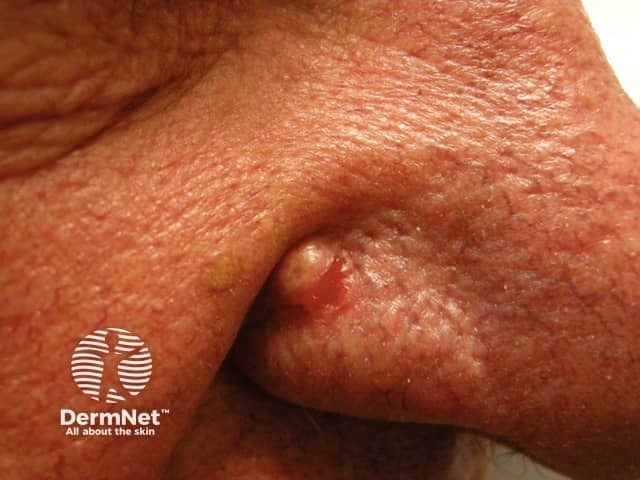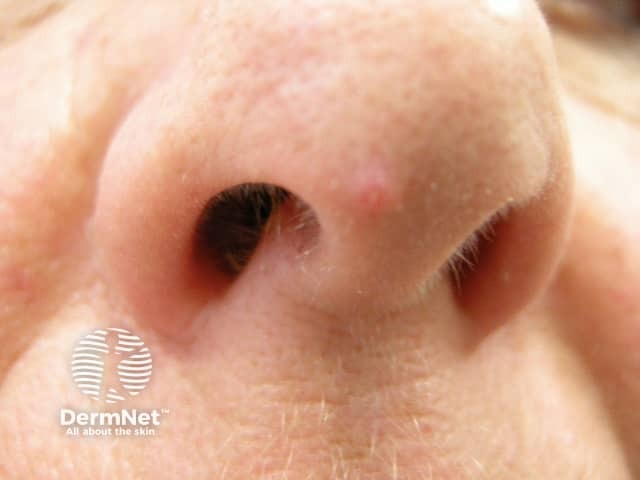Main menu
Common skin conditions

NEWS
Join DermNet PRO
Read more
Quick links
Fibrous papule of the nose — extra information
Fibrous papule of the nose
Author/s: Dr Amanda Oakley, Dermatologist, New Zealand, 2008. Updated: Dr Shawn Jordan, House Officer, ADHB; Honorary A/Prof Paul Jarrett, Dermatologist, CMDHB and Department of Medicine, The University of Auckland, New Zealand. Copy edited by Gus Mitchell. November 2021
Introduction
Demographics
Causes
Clinical features
Complications
Diagnosis
Differential diagnoses
Treatment
What is a fibrous papule of the nose?
A fibrous papule of the nose is a common and harmless skin lesion. It is a firm solitary papule that occurs on or around the nose and has a characteristic appearance under the microscope.
A fibrous papule of the nose may also be known as a fibrous papule of the face, solitary angiofibroma, or sporadic angiofibroma.
Who gets fibrous papules?
Fibrous papules are common and may affect anyone. They usually appear during late adolescence and early adulthood. Multiple fibrous papules can be present without any underlying disorder.
The presence of multiple fibrous papules may be associated with genetic conditions including tuberous sclerosis, Birt-Hogg-Dubé syndrome, and multiple neuroendocrine neoplasia type 1 (MEN1). In these conditions, the papules are numerous and widespread, often beyond the nasal area. They are harmless apart from the psychological problems they may cause due to their visible appearance.
What causes fibrous papules?
The cause of fibrous papules is not known.
What are the clinical features of fibrous papules?
They are often a single solitary lesion on or around the nose. The fibrous papule of the nose is dome-shaped, firm, non-tender, measuring approximately 1–6 mm in diameter. It can be skin-coloured, pigmented, white, or red in colour.

Fibrous papule of the nose

Fibrous papule of the nose

Fibrous papule of the nose
What are the complications of fibrous papules?
Fibrous papules are benign with no malignant potential.
How are fibrous papules diagnosed?
A fibrous papule is diagnosed by skin biopsy.
There are distinctive microscopic features including:
- Proliferation of fibroblasts, stellate, spindle, and multinucleated cells
- A fibrotic stroma
- Dilated blood vessels.
Many of the histological features may also be seen in other types of angiofibromas and it can be difficult to distinguish them histologically. For this reason, a fibrous papule is currently considered to be a variant of angiofibroma. There are several histological subtypes of fibrous papules including:
- Hypercellular
- Clear cell
- Pigmented
- Granular
- Epithelioid
- Pleomorphic
- Inflammatory.
See also the clear cell fibrous papule pathology page.
What is the differential diagnosis for a fibrous papule?
Fibrous papules may be similar in appearance to other skin lesions. They can be differentiated via biopsy and other clinical features:
- Basal cell carcinoma
- Melanocytic naevus
- Dermatofibroma
- Adnexal neoplasms including trichoepithelioma, trichofolliculoma, trichodiscoma, and perifollicular fibroma.
What is the treatment for a fibrous papule?
Fibrous papules are harmless, do not require any treatment, and remain stable. They may be removed for cosmetic reasons by shave biopsy, excision, cryotherapy, laser therapy, and electrosurgery.
Once removed, fibrous papules rarely recur.
References
- Chan JY, Wang KH, Fang CL, Chen WY. Fibrous papule of the face, similar to tuberous sclerosis complex-associated angiofibroma, shows activation of the mammalian target of rapamycin pathway: evidence for a novel therapeutic strategy?. PLoS One. 2014;9(2):e89467. Published 2014 Feb 18. doi:10.1371/journal.pone.0089467. Journal
- Damman J, Biswas A. Fibrous Papule: A Histopathologic Review. Am J Dermatopathol. 2018;40(8):551–60. doi:10.1097/DAD.0000000000001083. Journal
- Sand M, Sand D, Thrandorf C, Paech V, Altmeyer P, Bechara FG. Cutaneous lesions of the nose. Head Face Med. 2010;6:7. Published 2010 Jun 4. doi:10.1186/1746-160X-6-7. Journal
On DermNet
Other websites
- Fibrous Papule of the Face — Medscape Dermatology
- Fibrous Papule of the Face — The Australasian College of Dermatologists
